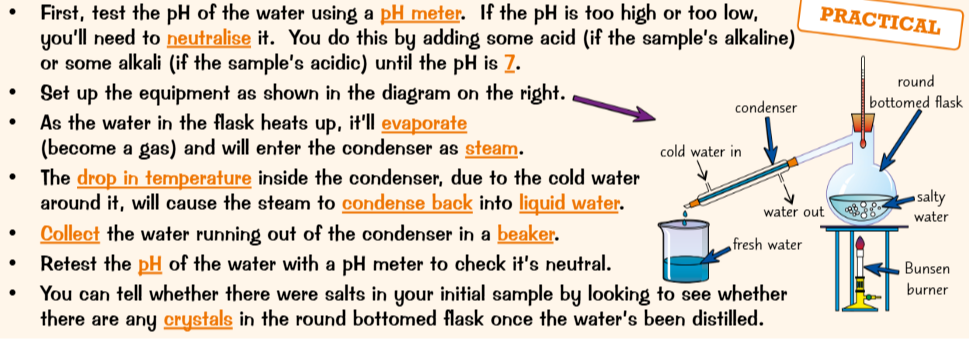C10- using resources
1/13
There's no tags or description
Looks like no tags are added yet.
Name | Mastery | Learn | Test | Matching | Spaced |
|---|
No study sessions yet.
14 Terms
what are natural resources
resources that form without human input. they include anything that comes from the earth, sea or air
what is a finite resource
finite (non renewable) resources aren’t formed quickly enough to be considered replaceable. Finite resources include fossil fuels and nuclear fuels. After they’ve been extracted many finite resources undergo man made processes to provide the fuels and materials.
2 ways of sustainably extracting copper from ores
Bioleaching - bacteria are used to convert copper compounds in the ore into soluble copper compounds, separating out the ore in the process. the solution produced by the process contains copper ions, which can be extracted by electrolysis
Phytomining - this involves growing plants in soil that contains copper. The plants cant use or get rid of the copper so it gradually builds up in the leaves. the plants can be harvested, dried and burned in a furnace. the ash contains copper compounds which can be extracted
how are metals recycled
by melting and casting them into the shape of a new product.
how is glass recycled
seperated by colour and chemical composition
crushed
melted to be reshaped
what is the life cycle assessment
it looks at every stage of a products life to assess the impact it would have on the environment
stage 1 of the life cycle assessment
getting the raw materials
extracting raw materials needed for a product can damage the local environment
raw materials often need to be processed to extract the desired materials and this often needs large amounts of energy.
stage 2 of the life cycle assessment
Manufacture and packaging
this can use a lot of energy resources and can also cause a lot of pollution
stage 3 of the life cycle assessment
using the product
the use of the product could damage the environment. for example burning fuels releases fossil fuels, fertilisers can leach into streams and rivers causing damage to ecosystems
how long it is used for and how many uses it gets is also a factor
stage 4 of the life cycle assessment
product disposal
products are often disposed of in landfill sites. This takes up space and pollutes land and water.
energy is used to transport waste to landfill which causes pollutants to be released into the atmosphere.
what is potable water
water that has been treated or is naturally safe for humans to drink.
chemists wouldn’t call it pure because pure water only contains h20 molecules where as potable water contains lots of other dissolved substances
how is fresh water treated to be safe to drink
filtration - a wire mesh screens out large twigs etc, and then gravel and sand beds filter out any other solid bits
sterilisation - the water is sterilised to kill and harmful bacteria or microbes. this can be done by bubbling chlorine gas through it or by using ultraviolet
how can seawater be treated to provide potable water
distillation

sewage treatment process
screened - involves removing large bits of material
sedimentation - the heavier suspended solid sink to the bottom to produce sludge while the lighter effluent float on top
the effluent is removed and treated by aerobic digestion
the sludge is removed and transfered into large tanks where it gets broken down in anaerobic digestion.